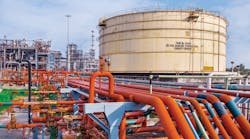If you ever thought exploration and production meant huge outlays of cash for oil and gas projects in far-off locales, think again. Now, with a little help from the inventive Japanese, the next energy source is as close as your nearest garbage can.
Consider the work of Eicoh Co., which has commercialized a system called Yukaki that produces reclaimed oil from waste plastic. To produce the oil, Yukaki-to be familiar-first pulverizes and melts such waste plastics as polyethylene.
Then Yukaki heats the plastic to some 400º C. in a thermal decomposition tank to vaporize it, whereupon the collected gas is cooled and the oil taken from it. We are told the extracted oil is the equivalent to fuel oil, which can be used to fuel generators and other heavy machinery.
Ingenious? Well, consider another idea coming from Japan to reduce waste and enhance the performance of power stations, while increasing the production of a form of natural gas.
Shellfish interests
This idea comes from researchers at the University of Tokyo and the National Institute of Advanced Industrial Science and Technology who have worked with Kajima Corp. to develop a way to process shellfish that encrust water intake openings at power stations and factories that use seawater for cooling.
The shellfish tend to hamper water flow and need to be periodically removed, but disposal sites are in short supply. Worse, the shellfish cannot be used for food and-if left to sit-develop foul odors.
Under the new method of removing and processing the shellfish, both the shells and the meat are processed at the same time to recover usable substances from both. The shellfish are first put in a solution of acetic acid, which dissolves the shells, allowing the meat to be removed.
The meat is allowed to ferment in order to generate methane, while the solution of dissolved shells is processed to recover calcium carbonate, which can be used for cement, paper, and other products. Even the acetic acid can be recovered and reused.
Algae power
Then, again, Tokyo Gas has begun marketing a new power-generation system that employs fuel gas derived from the algae that accumulate in harbors.
Collected algae are now simply incinerated, but disposing of 1 ton involves energy consumption equivalent to 30 cu m of city gas due to the high water content.
The new system flips this around and actually creates energy from the processing of the algae. The collected algae are pulverized and then fermented in tanks to generate methane. The methane is then mixed with city gas to maintain a stable heat value when the gas is burned to generate electricity.
Thinking of your next elephant? Forget it. We have an idea that involves sushi...

